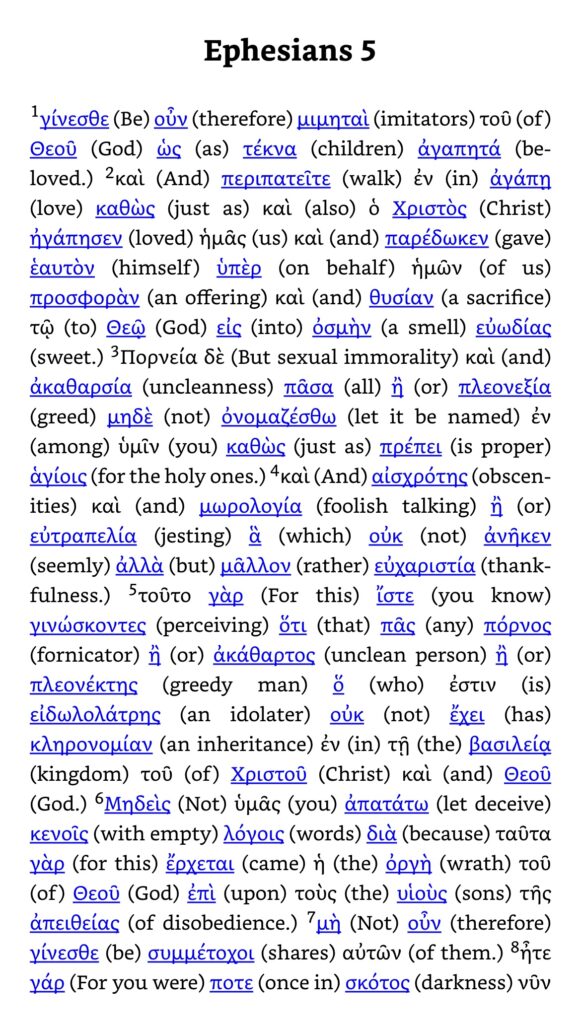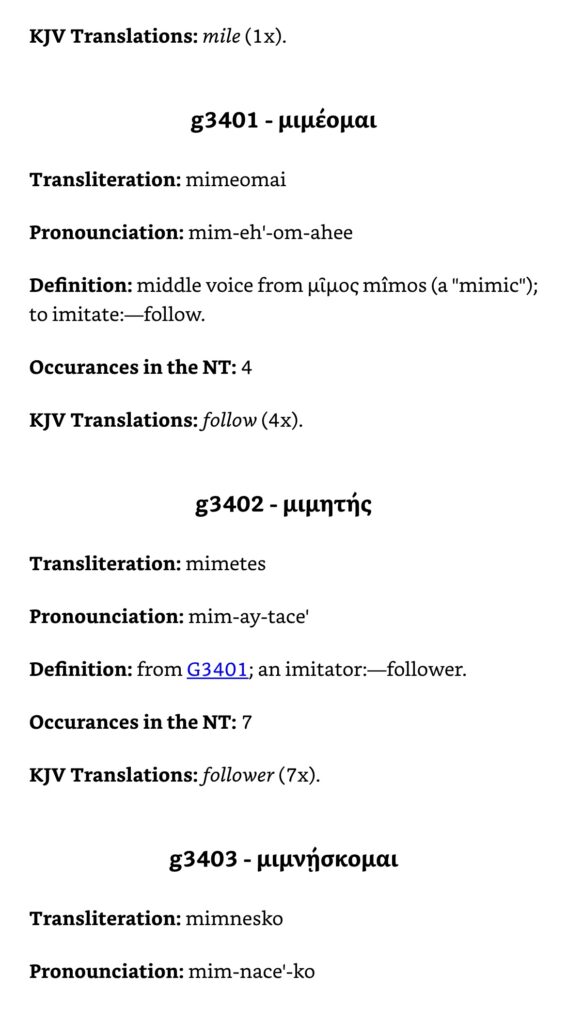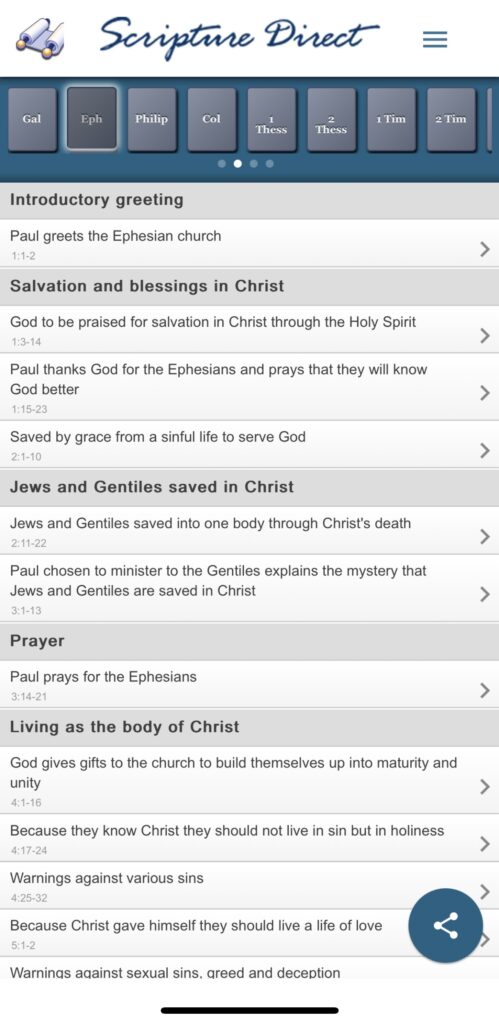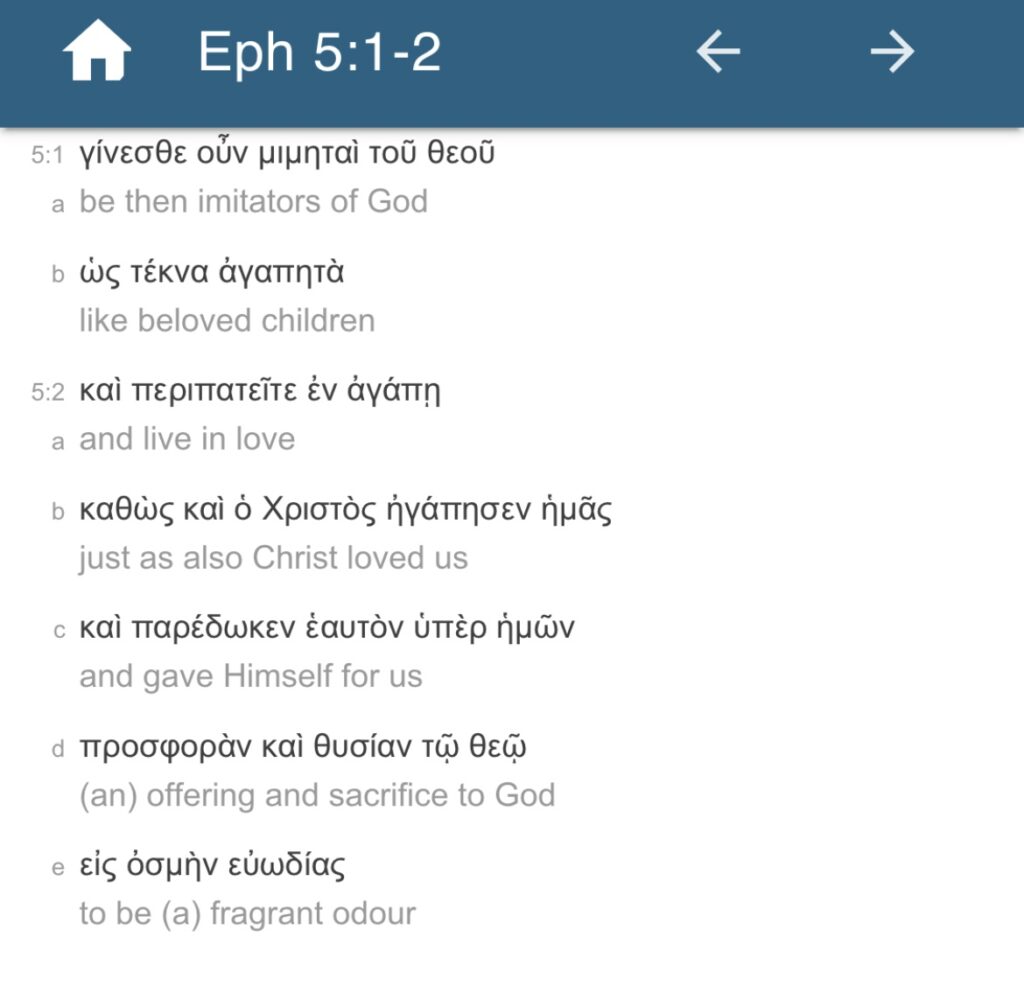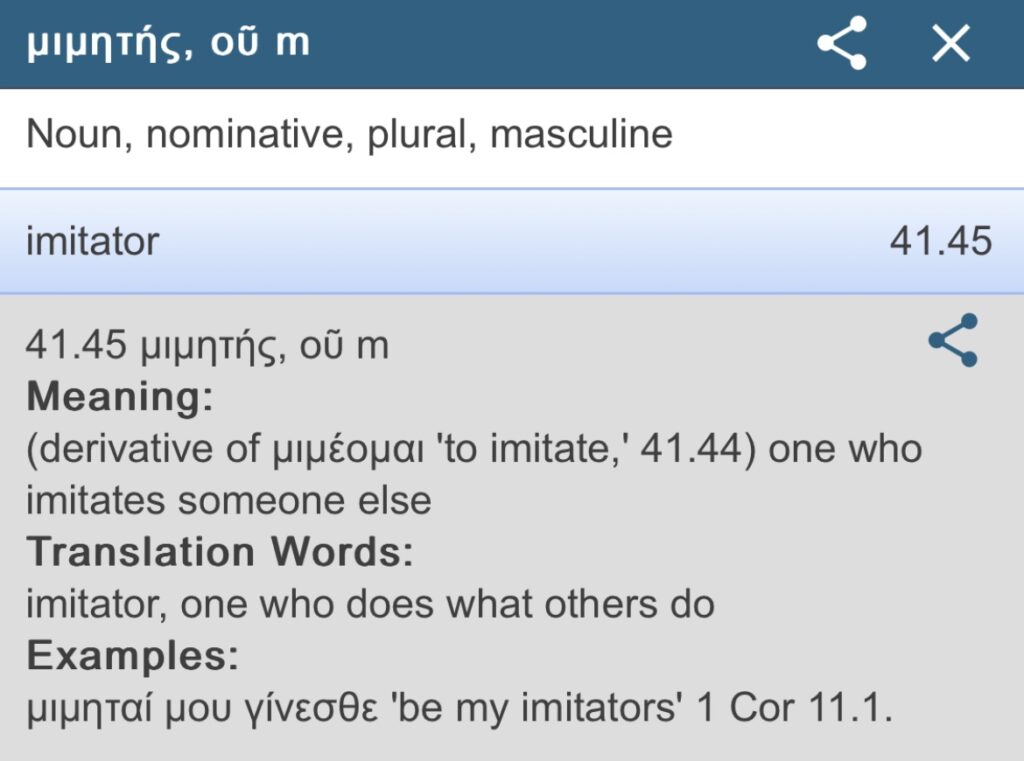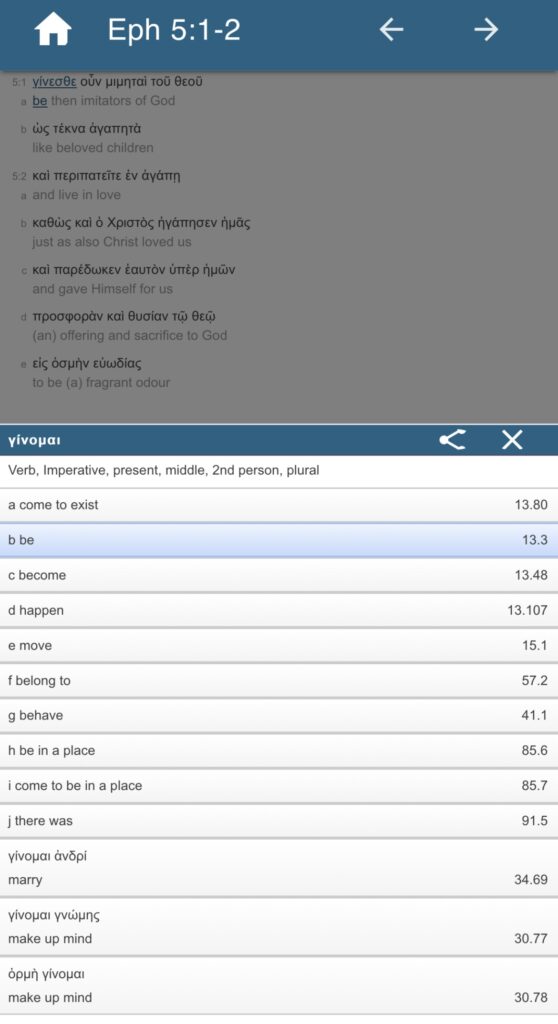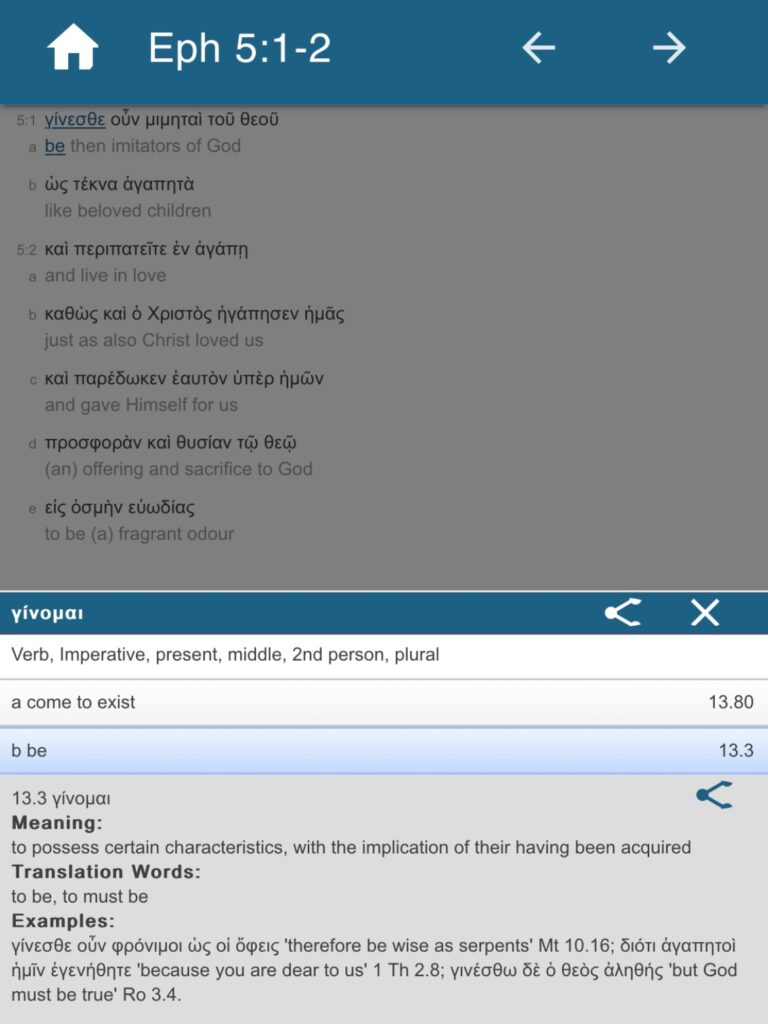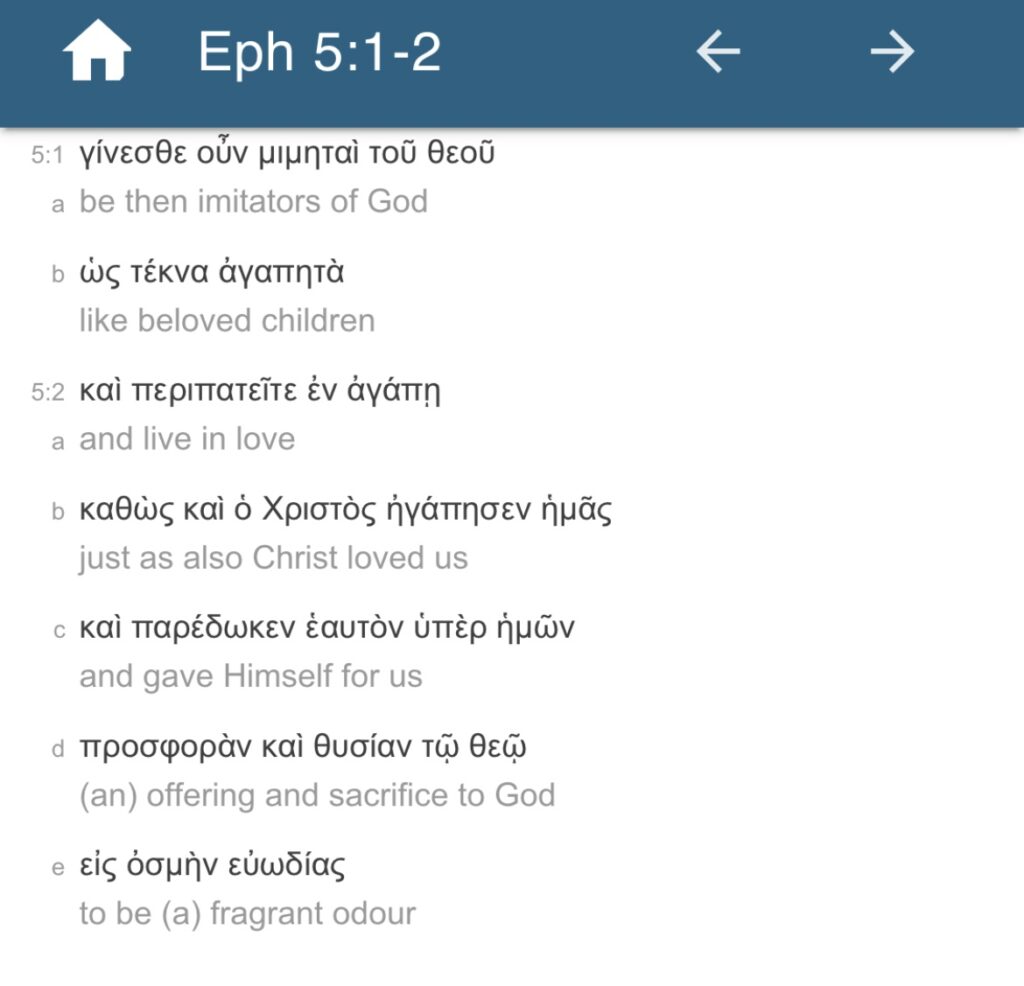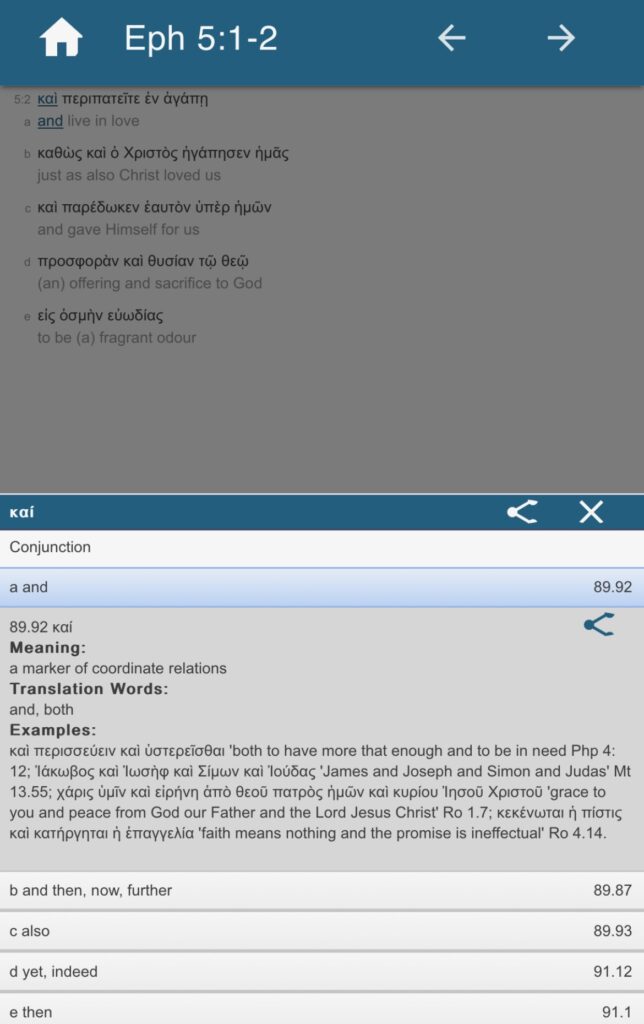One of our distinctives here is cohering observations into Themes of a longer passage, especially that of an entire Book. Our Book for this Exemplar Study is 2 Timothy, the final writing of the Apostle Paul in the Bible.
We discover, shape, re-conceive of Key Themes by uncovering and ruminating on Key Words.
Discovering Key Words in a Text or Book
Here we will consider five ways of Key Word Discovery (KWD).
- Word frequency
- A particular word (KWD) that establishes a head / universal (Head Word) that is developed into sub-headings / particulars.
- A particular word (KWD) that expresses an idea expressed by other words parallel in significance (not as Subheaded Words).
- Insights derived from consideration of Koine kai, which word is widely discussed on this site.
- Insights derived from considerations of the use of the Dative Case (DAT1, DAT2, and DAT3), introduced briefly in this post.
Word Frequency
Consideration of word repetition is not a perfect indicator of relative significance, but it is a good starting point. There are several ways to do this. The most powerful means of determining word frequency by the use of Bible software such as Logos, specifically its “Concordance” tool; this will be demonstrated here. Alternatively, the text can be copied from sites such as BibleGateway into a word processor and using certain functions available such as making a “Word Cloud” from within Microsoft Word, or brute force alphabetized ordering of all the words. Both of these latter approaches have serious limitations, as will be made clear below by use of Logos, but they can be of some initial value. As always, the work done by scholars who precede us by their creating abstracts / summaries / introductions (especially of whole Books), and outlines can be especially helpful starting points. A less valuable tool is collecting in order all the pericopes (paragraph or section / lectionary headings provided by publishers of Bibles) of any given passage or Book, again as a beginning point to discern ideas being repeated or developed.
Using the Logos tool “Concordance” can create word lists in many ways. Here we will consider the use of the options: English Standard Version + Lemma + 2 Timothy shown by absolute count. What this means is we are using the underlying manuscript (mss) of the ESV translation, and grouping together all the words that belong to the same “lemma,” that is the dictionary form (e.g., walk, walks, walked, walking would all be under a single heading), and the counts are solely for the single Book of our present study, 2 Tim. The tool then provides such lemmas in order of frequency. The ‘winners’ are always (it seems) the definite article “the” (149x in 2 Tim) closely followed by “kai” (68x).
Scanning the list for most-frequent words one finds: Lord (17x), Jesus (13x), Christ (13x), God (12x), faith (8x), “logos” itself meaning word or message (7x), and truth (6x). So if we add together the four obvious references to God– Lord, Jesus, Christ, and God–combined occur 55x in just the short 4 chapters and 83 verses of this Book. Further many, but not all, the many occurrences of “he” in various forms (again Logos gives us 16x) also reference God. So one immediate observation is that Paul in his final writing (that we have in Scripture) to his beloved spiritual son is focused on his Lord God seen by his recurrent reference to Him.
The Concordance Tool can also list the lemmas by part of speech: noun, verb, and so forth. Using the noun category we would note exactly the list given above, suggesting that the word frequency is dominated by nouns, a useful insight itself. Next on the noun list after “truth” are: work (6x), man (5x), day (5x), Grace (5x), and love (4x), with all remaining nouns occurring 3x or less.
If we restrict the list to verbs, the order of frequency is: the verb “to be” (16x), give / grant (6x), have (6x) know (6x), hear (4x), deny (4x), to become (4x), arrive (4x) with all remaining verbs 3x or less. So we can see clearly that nouns dominate verbs in this text, and, importantly, the most frequently occurring verbs are related to the concept of a revelation from God to men (give, know, hear, and deny).
So we may conclude that in Paul’s heart, by the guiding Hand of the Holy Spirit, is the Person of God Himself, and the verbs of being, being given (granted), knowing and hearing, all in the context of a culture that exists around the church, and even within it, that denies all of the above. This Epistle is reminding us of both the true reality, and its knowability as we need to know, and the opposition which does not cease in its opposing both the true and the knowing of it.
Key Word(s) Discovery (KWD)
Discovery of Key Words does not have a mathematical recipe as does word frequency. We need to look at the text itself and search for those focal points in which one or a few words encapsulate in some way a large body of the text that surrounds it / them. Sometimes this is locatable by the beginning sentence or two of an extended passage. This is a common occurrence with the English practice of paragraphs wherein the opening sentence is often the theme sentence of the paragraph. But sometimes a Key Word(s) can occur at the end of a passage. This is more common in text that builds an argument, a line of reasoning, toward a conclusion, such as the famous verse Rom 3:23: 23 for all have sinned and fall short of the glory of God (Rom 3:23, ESV), which encapsulates the opening three chapters of Romans. Our understanding of its significance derives from its content and context which context follows:
21 But now the righteousness of God has been manifested apart from the law, although the Law and the Prophets bear witness to it— 22 the righteousness of God through faith in Jesus Christ for all who believe. For there is no distinction: 23 for all have sinned and fall short of the glory of God,24 and are justified by his grace as a gift, through the redemption that is in Christ Jesus, 25 whom God put forward as a propitiation by his blood, to be received by faith. This was to show God’s righteousness, because in his divine forbearance he had passed over former sins. 26 It was to show his righteousness at the present time, so that he might be just and the justifier of the one who has faith in Jesus.
Rom 3:21-26 (ESV)
As shown above by underlining, the story (exposition) of Rom 3:23 does not end at “fall short,” but in the triumph of being “justified,” and by the sole condition of “grace as a gift” and means “in Christ Jesus.” As will be briefly discussed below, and more widely elsewhere, this latter phrase is a Koine dative case form, often appearing in Paul’s writings, deep with significance. Prepositions are often dismissed as baring little significance. Here the little preposition “in” points to a big idea: we look and feel like discrete entities as we journey through life, have associations with others, perhaps an intimate bonding within marriage (and there’s the “in” of “within” conveying a parallel idea). But the Scriptures tells us as the redeemed that we have been joined “in” Christ (Messiah-Redeemer) Jesus.
Another means of identifying KWD is recognizing repetition and development by the use of closely-related words with distinctive meaning, perhaps nuanced, perhaps a form of parallelism such as exists in the OT Wisdom Books, and is a traditional tool of scholarly writing.
To aid this process of KWD is creating a one-page document of whatever necessary size in which the entire text under study can be included. A very useful means of doing this is by means of a spreadsheet such as Excel or Apple’s Numbers software.
Shown below is how this can be done with 2 Tim. Several points can be noted. For convenience, the Book is separated into individual tables by the respective chapter. This can be segmented in other ways as the chapter divisions have no Biblical significance, given that it was 12 Centuries after the completion of the New Testament before they were man-created into the form as we know them today. As the respective chapter texts are pasted into its own table the text is naturally divided by the paragraph separations of the original text format (which, again, has no authoritative significance, as there is no paragraphing in the original mss). Now one can remove the pericopes (paragraph headings) and cut and paste any sentences that appear better suited with a preceding or succeeding spreadsheet cell. Then one can provisionally go through the text using bold, underline, or italic, or other font format to create special identifications. Shown below are two simple forms: bold and underlining. Finally, one can now shrink the font size, or even hide, the cells that do not appear to originate or carry forward the words appearing to be KWD. This tightens the text to make it better available to see it whole and so aid the discovery of KWDs and the broader main ideas that they support.

(Note: the final verse, 2 Tim 4:22 has been cutoff in pasting the table. It reads (ESV), importantly: “The Lord be with your spirit. Grace be with you.”).
Finding the Main Threads: from KWD to the Broad Theme(s)…Seeing the Forest from the Leaves
In the above spreadsheet format of the complete text of 2 Tim (ESV), I have highlighted in bold the KWD that recur through the entire text from the very first verse–1:1 “the promise” and “apostle” as the gifted conveyer of the promise and its significance–down to the closing paragraphs (4:1-5; 4:7; and 4:11-18).
“The promise” has substance (content) and is substantive (deeply meaningful). It is to be preserved, and carried-forward by the next generation. Timothy and all others God has and will call. It is “True:”
- 1:13 “sound words,”
- 2:9 the very “word (mss: “The Logos”) of God,”
- 2:11 “trustworthy” (literally trust + worthy),
- 2:15 “the word of truth,”
- 2:16 the presence of the very “snare of the Devil,”
- 2:25 providing “knowledge of the truth” (again at 3:7),
- 3:8 “the truth,”
- 3:16 the great sentence on Scripture as being “God-breathed” leading us to understand the written texts of Scripture as we have it is the very Spoken Word of God, such as at Creation itself (Gen Ch 1) make into visual, written form,
- 3:17 it is “complete” meaning that it is everything which foundation God desired to lay before us (which is not the same thing as everything that we might know, or ultimately will know…not every question can be answered, but we have what is fully sufficient),
- 4:2 it is authoritative for reproving, rebuking, exhorting, and teaching,
- 4:4 it is “true,”
- 4:13, 15, 17 it is instantiated in a “message” given and recorded in books and parchments (many thousand of which we have in our day).
Embedded in The Above Broad Theme is Opposition
In the midst of all of the above noted key ideas and words we find also reference to opposition and the poison that can derive from it:
- 2:14 “the quarrel,” implying its inevitable appearance, that ruins the hearers of the Message / Truth,
- 2:16 the presence of “irreverent babble,”
- 2:23 “foolish and ignorant controversies” that inevitably lead to, “breed quarrels,”
- 2:26 the active presence and word of “The Devil” himself in opposition to the Message / Truth,
- 4:5 the need for enduring “suffering,”
The Balance of Adhering to the Truth and the Message of It and The Opposition
Also evident in 2 Timothy is the proper response to both holding firmly and expressively to the “promise,” “message,” “Truth,” in the face of the “babble,” “quarrels,” the hidden and not so hidden work of the Devil, while experiencing “suffering,” Timothy (and us) is called to:
- 2:14, 16, 23 to refrain from both quarrels, babble, and irreverent controversies
- 2:24 and beyond only refraining…to “be kind” “patient,” inclined “to teach,”
- 4:5 to be “sober-minded,” “enduring suffering”
It is all too easy as most of us have experienced within ourselves and seen in others to fall off to the ditch on one side or the other: being soft and flimsy on upholding the message as True, on the one hand, or forceful, harsh, defiant with words and actions after any who may appear to be questioning or doubting, on the other hand.
Rather, Timothy is admonished to rightly deal with both such inclinations, to be firm but kind even toward those who oppose him or his teaching. The Lord Himself was our exemplar in such doing and being.
Dative Case Expressions in 2 Timothy
As discussed in several previous posts, including one on Romans 3:22-23, the Koine Dative Case form is an important grammatical expression. The default meaning of the dative case, which I designate DAT1, is that of identifying an indirect object: John hits the ball (direct object) to Jim (indirect object, DAT1).
The second category, in my enumeration, is the locative dative, wherein location can be in space or time, and which I designate DAT2: John and Jim met in high school (DAT2, space / location), or, alternatively, met in 1990 (DAT2, time).
The richest meaning of a dative case, my DAT3, represents agency / instrumentality: John learned to play the piano in The Juilliard school of music (DAT3, although it can refer to the space / location of such college the context is clearly that it was through the agency / instrumentality of the college that John learned to play his instrument).
Koine provides the morphological inflections that inform us of the dative case. However, it does not provide any inherent distinction among such three (or other) possible meanings of the dative case. Such meaning, significance, must be discerned from the context of its usage, as we have just done in the three brief examples of our imaginary character “John.”
Again using the power of the Logos software, we can identify 69 occurrences of the dative case in this brief Epistle. Such large number is intimidating but also points to the significance of such usage.
Looking first at frequency of occurrence, the most common in 2 Tim is DAT1 where Paul describes how the message of the Gospel was received: 1:17 “God gave us,” 3:11 “happened to me,” and multiple other such DAT1 usages.
But of highest interest to us, in accordance with the large Theme identified above, are the following occurrences (7x): 1:1, 9, 13; 2:1, 10; 3:13, 15 “in Christ Jesus.”
One might think that such “in Christ Jesus” dative forms point to a locative meaning, DAT2. And one can see such being the case from God the Father’s view unto us whereby He sees us positionally (located in a Spiritual sense) within Jesus Christ and so under His propitious gaze and under His blessing. And by the Biblical passages of the soon-to-come marriage supper of the Lamb there will be an eternal union experience of us wed into Christ which is somehow presently true but not fully realized as it will one day be.
Yet beyond the above, there is a crucial teaching of the Gospel that claims such union with Christ did not originate with us, nor was it accomplished by our deeds and powers, but came to be as a consequence of Christ’s Sovereign Work of Redemption. This is the essence of agency / instrumentality, DAT3. And the matter is so significant that such dative construction occurs “in Christ Jesus” seven times in this short Epistle, and in the dominant theme of the True Message (The Logos) of the Gospel, and many other places in the New Testament, especially in the Pauline texts.
kai Occurrences in 2 Timothy
As this website weaves around the use and significance of the connective (‘hinge’) word kai, let us here note that it occurs in almost every verse. Specifically it occurs 69x in the 83 verses of 2 Timothy.
One useful way of identifying all such occurrences of kai is by using the Blue Letter Bible free website. One needs to use the “Strong’s Number,” which for kai is G2532, to enter in the search field of that website. Then one selects just the Book of interest, here 2 Timothy. The result in any favorite translation is a list of the all the verses with kai in such chosen translation, though because such is in English the kai itself is not shown but appears as that translation has chosen to express it (frequently “and”).
To find kai as it occurs in the Koine mss, one performs the same Strong’s number search but instead choosing either of two Koine mss: MGMT or TR, which designates the so-called “majority” corpus of mss, or the “received” corpus, respectively. The discussion of the distinctions between such two sources is beyond our present interest. Most-often, there is no difference as to the presence of kai. For those inclined toward the KJV, the choice would be TR; for the majority of of other translations (ESV, NASB, NIV, etc.), the choice is MGMT.
Whichever choice is made, the result is a complete listing of every verse in 2 Timothy in Koine script. Because of its uninflected simplicity all occurrences of kai are easy then to identify. In order then to see the entire verse in English, knowing the presence of kai, one has to click on the adjoining “tools” button beside each such verse. This yields an interlinear presentation, enabling one to see the presence and usage and default English translation of the corresponding with each kai in its context.
(As it happens, in 2 Tim, there is a slight difference in the number of kai occurrences between the MGMT and TR: the former has 68x and the latter 69x. Such difference is an example of the mss variances that occur within the MGMT corpus itself and between it and the TR; the prevailing view of serious, fair minded scholars is that the vast majority of such variances do not carry with them any material doctrinal distinction, though there are a few textual differences that continued to be debated as the quest for the most-perfect mss reflecting the autograph mss continues, causing us to dig deeper, as it appears God would have it so).
The Danger, and Ruin, of Reviling
While we have briefly noted above the slight difference in the two notable Koine corpus families, let us briefly look at the Bible’s reference to “reviling.” The relevance of “reviling” to these two mss families is that there is, very regrettably, multiple examples of the distinctions in such families that has resulted in reviling, brother against brother. This idea of reviling fits also with the above KDW and Theme of 2 Timothy as holding to the Truth and facing opposition as that can also, sadly, result in reviling, not grace and patience.
There are three Koine words whose root meaning is reviling: loidoría (G3059), the verb form “to revile,” loídoros (G3060) the adjective form translatable as “reviling,” and loidoréō (G3058) often as a noun, namely “reviler.”
As with our previous use of the Blue Letter Bible website, one can now use each of the above Strong’s numbers (G3059, etc) and find all the uses again in either a MGMT based translation (ESV, NASB, NIV, etc) or based on TR (KJV, and a few others). As before, by using the search corpus as MGMT or TR instead of, say, ESV, one can see the verses with the respective word for reviling as given in the Koine mss, though it is inflected in various forms that requires recognizing at least some of the Koine alphabet. Again by clicking on the “tools” button, one then sees the interlinear form, verse-by-verse, that shows in English the context of where the search word appears.
For G3059 , there are three occurrences, notably twice in one exemplary verse: “Do not repay evil for evil or reviling for reviling, but on the contrary, bless, for to this you were called, that you may obtain a blessing.” (2 Peter 3:9, ESV).
For the verb form G3058, there are four occurrences, notably: “and we labor, working with our own hands. When reviled, we bless; when persecuted, we endure;” (1 Cor 4:12, ESV).
Finally, for the noun G3060, there are two NT occurrences, notably: “But now I am writing to you not to associate with anyone who bears the name of brother if he is guilty of sexual immorality or greed, or is an idolater, reviler, drunkard, or swindler—not even to eat with such a one.” (1 Cor 6:10, ESV). “Reviler” is embedded in a truly bad list, perhaps an ordered list.
It should also be noted that Blue Letter Website provides access to the Greek of the OT, known as the Septuagint (abbreviated LXX). Very briefly, the LXX was translated in, or maybe not, Alexandria, in or maybe not 200 B.C., by 70 scholars (hence the Latin 70, LXX), or maybe not. There is a degree of ambiguity of its exact date and origin, but it is generally regarded as a useful parallel to the Hebrew OT, as its form was widely quoted in the Koine NT, and in any case provides us a kind of binocular view of the OT. For our noun word reviling, we can find two Proverbs instantiations, including: “As charcoal to hot embers and wood to fire, so is a quarrelsome [loídoros] man for kindling strife.” (Prov 26:21, ESV)
I’ve added this particular discussion for the additional reason that we should all be reminded of the possibility that such Kai Studies deep dive work can tempt us or bring us into argumentation unto quarreling unto loidoría (G3059). Accordingly, let it not initiate kindling into flames by remembering Paul’s admonition to Timothy in the above Epistle: to be kind, patient, yet apt to teach.
